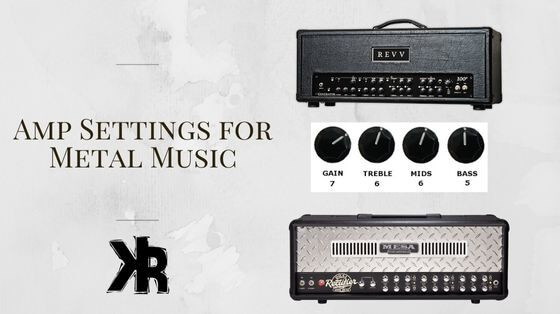Table of Contents
Getting the right guitar amp settings for metal tones is of huge importance when you are a high-gain player.
Guitarists go to great lengths in search of the perfect metal tone, and there are a lot of options to consider. One of the more important factors in finding this tone is your guitar amplifier settings.
In this Killer Rig article, we will explore different metal amp settings to see what works best. We will also look at tips you can use to fix your sound and explore some gear and how to use it. In the end, you will be on your way to a more aggressive, thick sound!
What is a Good Metal Tone?
There are many metal sounds today that consist of heavily distorted guitars. Sometimes they are scooped by lowering the mid-range, like Metallica songs. Sometimes they are mid-heavy, bright, and thick.
When it comes to metal sounds, you want as much gain as needed with the perfect equalization.
This means that you may need a saturated, high-gain sound, but not always. You’ll also want to have the bass, midrange, and treble frequencies adjusted to your liking.
For example, you may want a punchy bass with the treble turned down a bit. A tone that is heavier and chunkier with added mid-range to cut through the mix. A good metal tone can be achieved with these starter amp settings:
- Gain: 7
- Bass: 5
- Mids: 4
- Treble: 6
Understanding the Amp Settings
There are 5 main controls that you will find on your amplifier that you need for a great metal tone:
- Gain.
- Treble.
- Mid-range.
- Bass.
- Volume.
Each of these controls is critical to the tone that you might be seeking when it comes to metal music. But do you know how each one affects your sound? Let’s look at gain and EQ in greater detail.
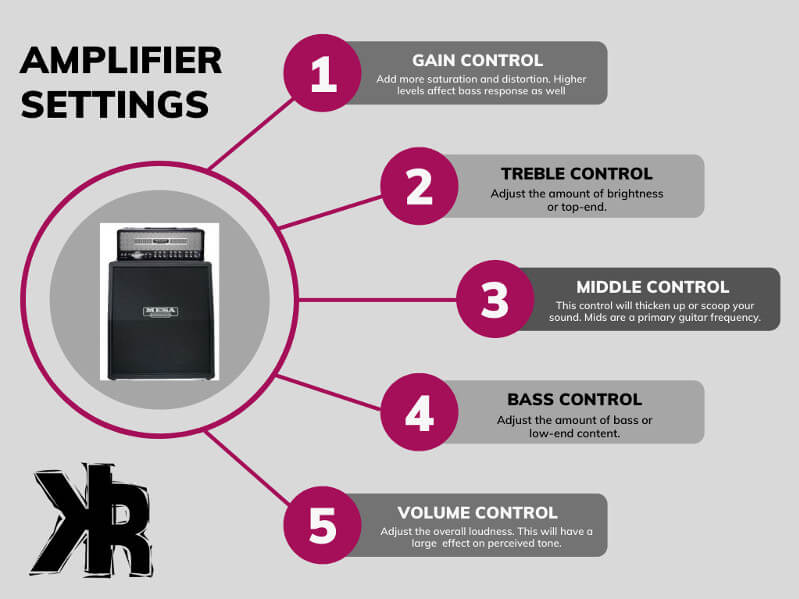
Gain
While a lot of people believe that metal music just means you crank the gain, this isn’t always true. Yes, metal does need a higher gain setting. But sometimes players keep it lower and don’t want as much saturation.
Higher gain settings also mean more bass content, as they affect each other. Sometimes this can be too muddy sounding, and so the right gain setting is crucial. If you find you have a muddy or boomy sound, your gain might be too high.
Some amplifiers just have too much bass. No matter how you dial it in, it’s overbearing. In this case, you may need a boost pedal to tighten it up. We’ll look at that more in this article.
It’s also worth mentioning that on some amps, this control is sometimes also called drive. Set it to get the preferred distortion for your sound. But don’t over do it.
Treble
Most metal players will go for a brighter sound. The bite in a high gain tone can be found in the treble frequencies. But if the sound you are going for is darker, then this control may need to be lowered.
The treble should be set to be cutting, but not shrill or thin. Adjusting this control is important depending on the type of metal you play. Darker, thicker tones will need a lower setting. While more modern, searing sounds need a higher setting.
Mid-range
A lot of metal tones have a scooped mid-range. This can be done by either lowering the mid-frequency or turning it right off. This will depend on the amp and what sound you are going for.
Some guitarists like a mid-present sound that cuts through a mix and is used more in some Nu-metal tones. This is an important control that can also add to a throaty tone.
Mids are the primary guitar frequency. So it’s one of the more important controls on your amplifier. More modern metal tones rely on higher settings. Old-school Metallica, however, keeps the mid-range low!
Bass
Bass can be a tough control to use in some forms of metal. If you are looking for a tight but full sound, sometimes the amplifier has to be just right. Not all amps can provide a tight, full bass response.
Some of them are far too bass-heavy and just don’t do some metal sounds well. But there are some amps that have a punchy tight bass, great for many metal types.
Gain also affects the bass, which can make a saturated metal tone hard to dial in. The higher the gain, the more pronounced the bass frequencies. But sometimes it can be removed with the bass control.
When you adjust your gain, you will also need to fine tune the bass setting. This is one thing to keep in mind with gain-level changes.
Volume
The volume control can add to a heavily saturated metal sound. If you have a tube amplifier, turning up the volume can begin to distort the power section. When this happens, it adds another layer of distortion.
Do you run your amplifier loud? Then you may need to back off the gain to keep your saturated sound under control. If you feel like you can use a little more push, turn it up. Once you drive the power tubes hard, you can get more aggressive!
Presence
Another control that will need to be set to taste is your presence. Not all amplifiers will have this control, but it can be helpful if your sound becomes too fizzy.
It can also be a great control when you’re lacking brightness. Almost like there is a blanket over your speakers. This can really enhance your tone. Just use it in conjunction with your treble control. You don’t want a tone that is piercing or harsh.
Check out my guide on amp settings for a more detailed look.
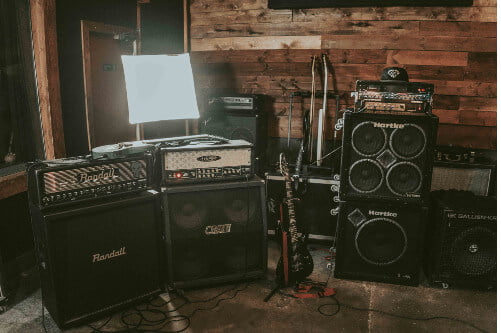
Amp Settings For Different Types of Metal
There are many different types of metal, each with their own tones. They will all require different amp settings to get right. Here are a few types of metal and the settings you will need to obtain them:
Scooped Tones
When looking for a scooped metal sound, try setting your amp up as follows:
- Gain: 7-8.
- Treble: 7.
- Mids: 2-3.
- Bass: 6.
These settings will keep the mid-range low, but boost the other frequencies. This will ensure a saturated and punchy tone with a good top-end bite. If you have depth and presence controls, they can be set at 5 to start, then adjust to taste.
These are great heavy metal amp settings. But they will also work with thrash and even speed metal. But it also depends on your guitar tuning.
If you are using a drop B tuning, then you will need to adjust slightly. Bands like Metallica and Pantera use these types of settings to get their sound.
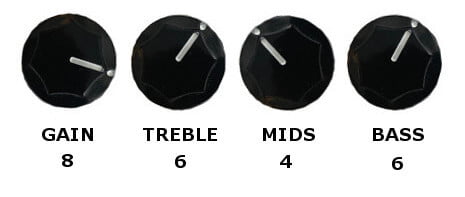
Melodic Metal
A melodic metal tone is much different, as you want more mids and less gain. In this case, think of a band like Periphery as an example. The sound needs to be fairly tight and full, and not muddy. Some good settings to get started would be:
- Gain: 6.
- Treble: 5.
- Mids: 6.
- Bass: 5.
Again, resonance and presence can be set flat. Then just adjust to taste based on your guitar and speaker choice. These are also great settings for Nu metal. I have experimented with power metal as well and had good results.
If you’re looking for metalcore amp settings, then use the settings above, but increase the gain and adjust the EQ to taste.
Popular Amplifier Settings
These are the more common amplifiers used for metal, but they need to be set correctly to sound good. I have provided some of the best metal amp settings below to help get you started!
Dual Rectifier
The Mesa Dual rectifier is an amplifier commonly used for metal. It’s also a tricky amp to dial in as the bass can be quite loose, and it can get fizzy if not set right.
When using the Mesa for any type of metal, the settings will need to be quite different depending on what you are going for.
Are you going for a scooped metal sound? Then use the second channel in modern mode, and the settings should be as follows:
- Gain: 8.
- Treble: 5-6.
- Mid: 3-4.
- Bass: 6.
- Volume: 4.
- Presence: 6.
The Dual rectifier is scooped by design as it is, so this tone will be right where you need it. Slight tweaks might be needed depending on the guitar you are using.
For a thicker metal sound with very a present mid-range and brightness, use these settings:
- Gain: 5-6.
- Treble: 5.
- Mid: 6.
- Bass: 4.
- Volume: 4.
- Presence: 5.
Use channel 3 set to modern mode and then adjust to taste with the guitar you are using. Bridge pickups will be best for this sound.
Peavey 6505
The Peavey 6505 is another great amp for many metal types. It’s also popular and can do most things very well and is somewhat easy to dial in. It can get very bright and honky, so use care with treble and mid-settings.
For a scooped metal sound on the 6505 lead channel:
- Pre Gain: 3.
- Post Gain: 4.
- Treble: 6.
- Mid: 2-3.
- Bass: 6.
- Resonance: 5.
- Presence: 5.
The thing about the 6505 is that when everything is set to about 6, the amp sounds pretty good. Which makes this a pretty good setting for any other metal types.
Related: Learn how to use Peavey amp settings.
Modern Tones
For a great modern metal sound, however, I preferred these settings on the Rhythm channel:
- Pre Gain: 6.
- Post Gain: 3.
- Treble: 6.
- Mid: 5.
- Bass: 6.
- Resonance: 6.
- Presence: 8.
Again, this depends on the guitar being used, but also the speakers. I found this amp worked well with V30s as my preferred speaker type.
Revv Generator 120
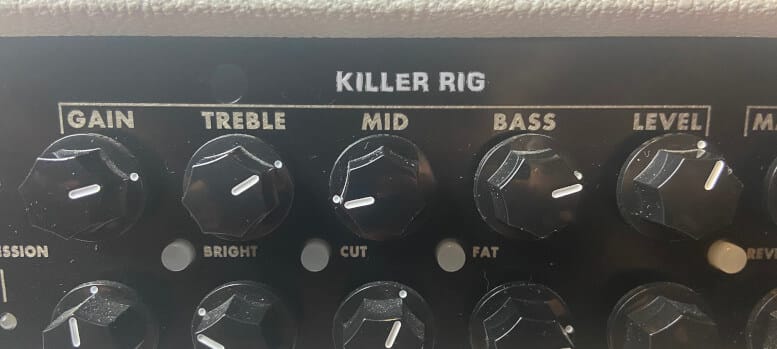
The Revv Generator is a killer amp and can get some very saturated metal tones easily! My settings for a scooped sound were found on channel 4 with the blue aggression level.
- Gain: 7.
- Treble: 6.
- Mid: 3.
- Bass: 6.
- Depth: 6.
- Presence: 5.
You will need to keep the bright, cut and fat switches off for these settings.
Modern
For a nu-metal tone, I used channel 3 in blue aggression mode, as it has a great mid-character. Again, for these settings, keep the bright boost off, the cut on, and the fat switch off.
- Gain: 5.
- Treble: 6.
- Mid: 6.
- Bass: 5.
- Depth: 5.
- Presence: 6.
Troubleshooting and Tips
Have you been trying to work with your gear, but just can’t dial it to your liking? Then there are a few things you can do to improve your sound.
Avoiding Muddy Tones
If your metal sounds are too muddy, you can try the following tips:
- Try rolling off your bass knob or using an EQ pedal in the FX loop.
- If you’re using dark pickups, they may be contributing to the muddy tone. Switching to brighter pickups can help.
- If you are using the neck pickup, try the bridge, as it’s less thick sounding.
- Add more treble and mids to your tone. Treble can help to cut through the mud and make your tone clear while remaining full thanks to the mid-range.
- If you have your gain setting unnecessarily high, the bass will also be increased as a result. Try lowering your gain and adjusting the EQ.
- Try a boost pedal in front of the amp. This way you can eliminate some bass from the source.
Thin Tones
When you’re looking for a full sound but find your tone to be too thin. There are a few things that you can try:
- Rolling off your treble knob can help to beef up your sound.
- Adding more bass can help thicken up a tone and make it fuller.
- With more gain, you’ll get additional distortion but also a thicker tone.
- Sometimes changing amps can help to improve the character of your tone.
- If you’re using a speaker that doesn’t have a lot of bass response, it may be contributing to your thin tone. Try changing to a speaker with more low-end.
- If you’re scooping your mids too much, they may be contributing to the thin sound of your tone. Try boosting your mids a bit to see if that helps.
- Try a different guitar. Most have drastically different tones, and not all will work for you. For example, a Stratocaster will not give you a thick metal tone with single-coil pickups.
These are merely a few pointers to assist you in creating better heavy metal tones you’re looking for.
You might have to try a few amps and guitars because each one is unique before deciding which one is best for you. Additionally, you may try including effects, which can alter your sound.
Conclusion
Achieving the perfect metal tone can be a challenge! But with a little experimentation, you should be able to find what you’re looking for, even if it is old school.
Be sure to have the right equipment as well, not all guitars and amps can produce a metal tone. Find out what others are using and get yourself the gear that works for the music style.

